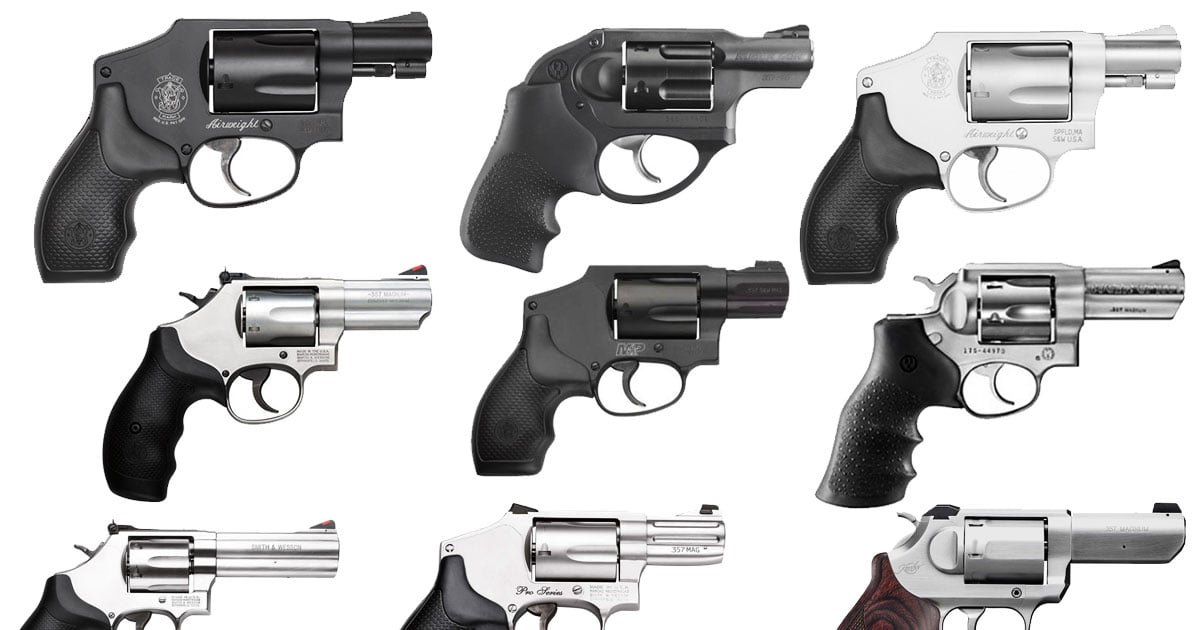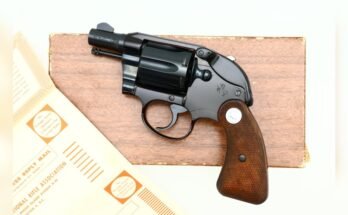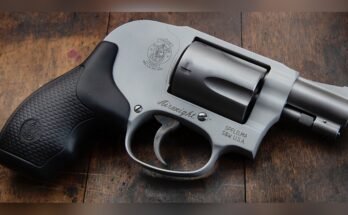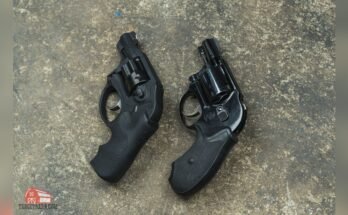When it comes to protecting yourself and your loved ones, choosing the right firearm can feel overwhelming. You might be wondering, are revolvers good for self-defense?
This question is more important than you think because your choice could make all the difference in a high-pressure situation. You’ll discover the real strengths and weaknesses of revolvers for self-defense. By the end, you’ll have a clear understanding to help you make the best decision for your safety.
Keep reading—you won’t want to miss these crucial insights.

Revolver Basics
Understanding the basics of revolvers is important for anyone thinking about self-defense. Revolvers have been around for a long time. Their design is simple and reliable. This makes them a popular choice for many people.
Revolvers work differently than other guns. They have a cylinder that holds several bullets. Each time you pull the trigger, the cylinder turns and lines up the next bullet. This simple action makes revolvers easy to use and maintain.
How Revolvers Work
A revolver uses a rotating cylinder to hold bullets. The cylinder usually holds five or six rounds. When you pull the trigger, the cylinder spins. This brings a new bullet in line with the barrel. Then the gun fires the bullet.
The hammer strikes the bullet’s primer to ignite the gunpowder. This creates pressure that pushes the bullet out. Revolvers can fire one bullet at a time without reloading. This mechanism is straightforward and reliable under stress.
Types Of Revolvers
There are two main types of revolvers: single-action and double-action. Single-action revolvers need the hammer to be pulled back manually before firing. Double-action revolvers fire by just pulling the trigger, which also cocks the hammer.
Single-action revolvers have a lighter trigger pull. Double-action revolvers are faster to shoot but require more trigger pressure. Both types can be good for self-defense depending on your skill and comfort. Each has its own advantages in different situations.
Advantages In Self-defense
Revolvers are simple to use and reliable for self-defense. They rarely jam and work well under stress. Their easy maintenance makes them a good choice for beginners.
Reliability And Durability
Revolvers are known for their strong reliability. They rarely jam or malfunction.
This makes them very dependable in stressful situations. The simple design helps avoid problems.
Durability is another key advantage. Revolvers can handle rough use and still work well.
Ease Of Use
Revolvers are simple to operate. Loading and firing do not require complex steps.
The controls are easy to learn. This is helpful for new users or those under stress.
Point and shoot. No need to worry about safety switches or magazines.
Low Maintenance
Revolvers need little cleaning and care. Their design makes them easy to maintain.
Fewer parts mean fewer things can break or get dirty.
Regular basic cleaning keeps them ready to use at any time.
Limitations To Consider
Revolvers have been a popular choice for self-defense for many years. They are simple and reliable. Still, they come with some limits. These limits can affect how well they work in a self-defense situation. Understanding these limits helps you make a smart choice.
Capacity Constraints
Revolvers usually hold fewer bullets than other guns. Most hold six shots or less. This means fewer chances to fire before reloading. In a dangerous moment, having fewer bullets can be risky. You might run out of bullets quickly if you face more than one attacker.
Reloading Speed
Reloading a revolver takes longer than other guns. You must open the cylinder and load each bullet one by one. This can take valuable seconds. In a high-stress situation, every second counts. Slow reloading can leave you vulnerable to attack.
Size And Weight Factors
Revolvers can be heavier and bulkier than other handguns. This can make them harder to carry all day. A bigger size may also make it harder to hide the gun. For some, carrying a heavy revolver is not very comfortable. This can affect how often you carry your gun for protection.
Comparison With Semi-automatics
Choosing between revolvers and semi-automatics for self-defense depends on several factors. Both types have unique traits that affect how they perform and feel in real situations. Understanding these differences helps in making a better choice.
Performance Differences
Revolvers have fewer moving parts and are less likely to jam. This makes them reliable under stress and dirt. They usually hold fewer bullets, often five or six. Semi-automatics offer higher ammo capacity, sometimes 10 to 15 rounds or more. Reloading a revolver takes more time and practice. Semi-automatics use magazines that reload faster and easier. Semi-automatics often have lighter triggers, which can improve accuracy. Revolvers tend to have a heavier trigger pull, which some find harder to manage. Both types deliver strong stopping power, but shot placement is key.
User Preference Trends
Many beginners prefer revolvers for their simplicity. Revolvers require less training to operate safely. Experienced users may lean toward semi-automatics for capacity and speed. Law enforcement and military often use semi-automatics for these reasons. Some users value the classic design and ease of use of revolvers. Others want the modern features and customization of semi-automatics. Personal comfort and confidence often guide the final choice. Trying both types at a range can help decide what fits best.
Expert Opinions
Experts share varied views on using revolvers for self-defense. Their opinions help us understand real-world effectiveness. They focus on reliability, ease of use, and stopping power. These factors matter most in critical moments.
Law Enforcement Views
Many police officers trust revolvers for backup weapons. They praise their simple design and strong build. Revolvers rarely jam, which is crucial under stress. Officers say revolvers are easy to operate quickly. Some prefer revolvers for close-range defense. Yet, others favor semi-automatic pistols for higher capacity. The choice often depends on training and mission needs.
Self-defense Instructors’ Insights
Instructors highlight revolvers’ straightforward use for beginners. They teach students to focus on accuracy and calm handling. Revolvers allow clear training on trigger control and aiming. Experts note revolvers need less maintenance than other guns. Some instructors warn about slower reload times. They advise practicing reloads to improve speed. Overall, many instructors see revolvers as solid self-defense options.
Choosing The Right Revolver
Choosing the right revolver is key for effective self-defense. The right choice depends on several factors. These include power, comfort, and safety. Each factor affects how well you handle the firearm. Let’s explore important points to consider.
Caliber Options
Caliber affects stopping power and recoil. Smaller calibers have less recoil and are easier to control. Larger calibers provide more stopping power but can be harder to handle. Common choices include .38 Special and .357 Magnum. Pick a caliber that balances power and control for you.
Ergonomics And Grip
Comfort matters in a self-defense revolver. The grip should fit your hand well. A good grip helps with aiming and reduces recoil impact. Look for grips that feel secure and comfortable. Try different models to find one that suits your hand size and shape.
Safety Features
Safety features prevent accidental firing. Many revolvers have a heavy trigger pull as a safety measure. Some models include transfer bar safety or hammer block. These features stop the gun from firing unless the trigger is fully pulled. Always choose a revolver with reliable safety mechanisms.
Training For Effective Use
Training is key to using revolvers well for self-defense. Regular practice builds confidence and skills. It helps you react quickly under stress. Training also reduces mistakes that can be costly.
Focus on drills that improve your aim and reload speed. Practice handling the revolver safely and smoothly. Good training prepares you for real situations.
Practice Drills
Practice drills improve your shooting accuracy and speed. Start with slow, careful shots. Then increase speed while keeping good aim. Dry firing helps you practice without ammo. It builds muscle memory for trigger control. Regular drills keep your skills sharp and reliable.
Scenario Training
Scenario training simulates real self-defense situations. It teaches you how to react calmly and correctly. Use safe environments to practice moving and shooting. Include unexpected events to test your responses. Scenario training builds mental readiness and confidence. It prepares you for the pressure of real danger.

Legal And Practical Considerations
Choosing a revolver for self-defense involves more than just picking a firearm. Legal and practical factors shape how you carry, store, and use it safely. Understanding these points helps protect you and those around you.
Carrying Laws
Every place has different rules about carrying guns. Some areas allow open carry, where the gun is visible. Others require concealed carry, with the gun hidden on your body. Many places need a permit or license to carry a firearm legally. Check local laws before carrying a revolver to avoid trouble. Knowing the rules keeps you safe and lawful.
Storage And Accessibility
Safe storage is key to preventing accidents. A locked safe or box helps keep the revolver away from children or thieves. The gun should be easy for you to reach quickly in an emergency. Find a balance between safety and access. Store the revolver where you can get it fast but others cannot. Regular practice with your storage method improves your readiness.

Frequently Asked Questions
Are Revolvers Reliable For Self-defense Situations?
Revolvers are highly reliable due to their simple mechanics and fewer malfunctions. They work well under stress and require minimal maintenance. This makes them a solid choice for self-defense, especially for beginners or those preferring straightforward operation.
How Easy Is It To Use A Revolver For Defense?
Revolvers are easy to use because they have a simple trigger mechanism and no complex safety features. Their straightforward design allows quick firing and easy handling, making them ideal for users with limited firearms experience.
Can Revolvers Hold Enough Rounds For Self-defense?
Most revolvers hold 5 to 6 rounds, which is less than many semi-automatic pistols. However, revolvers still provide sufficient firepower for typical self-defense scenarios, where accuracy and reliability are more critical than high capacity.
Are Revolvers Better Than Semi-automatic Pistols For Self-defense?
Revolvers offer simplicity and reliability, while semi-automatics provide higher capacity and faster reloads. The best choice depends on personal preference, training, and comfort with each type of firearm.
Conclusion
Revolvers offer simplicity and reliability for self-defense. They are easy to use and maintain. Their limited ammo capacity means quick reloads are needed. Many people trust revolvers for close-range protection. Practice and comfort with your firearm matter most. Choose what fits your needs and skill level.
Safety and training always come first. A revolver can be a solid choice in the right hands.



